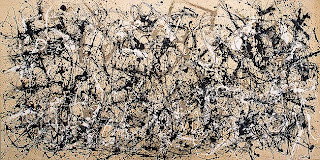Installation view from Rachel Uffner Gallery.
Sam Moyer: The Drink, 2012, ink and bleach on canvas mounted to wood panel, 82 by 120 inches.
Sam Moyer’s current show, Slack Tide, at Rachel Uffner Gallery consists of five paintings and one window sculpture. There are four paintings measuring about five by seven feet and one larger seven by ten foot painting. According to the press release, Moyer makes the paintings using ink and bleach in a process where she gathers and folds the canvas and then applies ink to the surface. When the canvas is unfolded the folds are highlighted white and the wrinkled surface is recorded on the flat surface of the canvas. Moyer then applies bleach to the canvas, creating bands of light that resemble the stripes of a bad photocopy and harken back to the subtle, somber lines of an Agnes Martin painting. The canvas is then ironed flat and mounted to wood panels.
The results of Moyer’s process are dramatic, melancholy, black and white compositions whose expansive space reads as bed sheets or the rippling surface of a body of water, and are also extremely topographical; they could be satellite images of the surface of the moon. They are essentially trompe l’ioel paintings; an indexical record of the fabric that once occupied three dimensions and now occupies only two. In that sense, her work is just as much in conversation with photography as it is with painting and much like Steven Parrino’s paintings, her process of recording the folds in the canvas is a record of the action and, once the canvas is flattened again, the action itself.
Steven Parrino: Untitled, 1997, enamel on canvas, 60 by 60 inches.
It is an idea that can be traced back to Jackson Pollock. Moyer’s action paintings at once call attention to the surface that is and once was, as well as the deep illusionistic space contained in the canvas. She works under Jackson Pollock in a similar vein as Simon Hantai; using a kind of ready-made folded surface to create an expressive, expansive image that is extremely conscious of the flat surface it exists on.
Simon Hantaï: Étude, 1969, oil on canvas, 103 1⁄8 by 89 3⁄4 inches.
However, where Simon Hantai excluded the illusionistic space present in Pollock’s paintings in favor of a flat space recorded from disruptions on the surface of the canvas, Moyer mines Pollock deeper by pushing illusionistic space even further. The sense of three-dimensional space present in Moyer’s paintings is augmented so much more than in say, Pollock’s “Autumn Rhythm,” that they almost deny the imagistic in favor of the tangible.
Jackson Pollock: Autumn Rhythm, 1950, oil on canvas, 105 by 207 inches.
Sam Moyer: Slack Liner I, 2012, ink and bleach on canvas mounted to wood panel, 82 by 64 inches.
In a sense they are really conventional: they rely on the illusionistic properties of painting that have existed since the renaissance. However at the same time, in the way they flirt with both the three-dimensional and two dimensional, with painting and sculpture, photography and drawing, and the way the paintings’ surfaces seem to penetrate out beyond the picture plane, they are really radical.






I really appreciate your review. Your point comparing Moyer to Pollock, I think, is spot on, and productively aligns her works with the practice of painting (more than, for example, photography).
ReplyDeleteMy blog is pretty new as well, but I linked to your review in my listing (http://wp.me/p2ig7N-3H). Maybe you can check out my review of Moyer's show if you'd like. Either way, I'm looking forward to reading more of your work!
-Tracy
Wow, thanks a lot Tracy! Ill check out your blog now.
Delete-Kevin